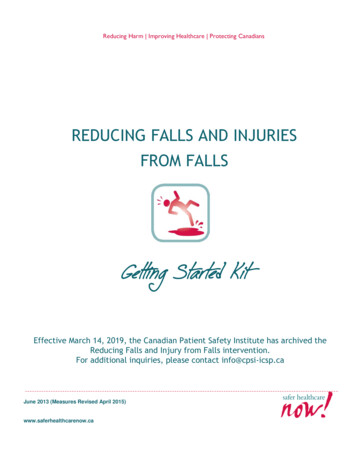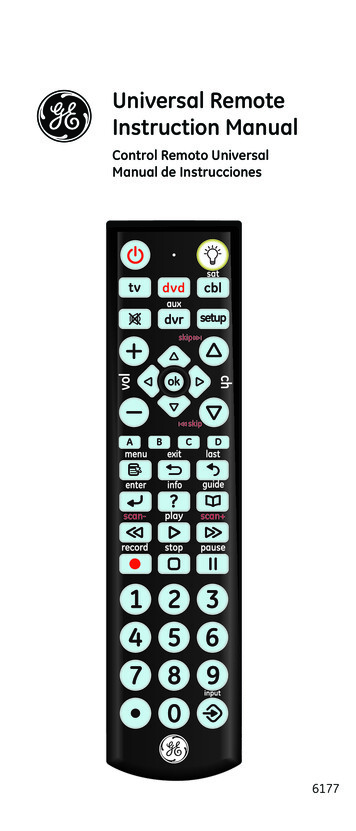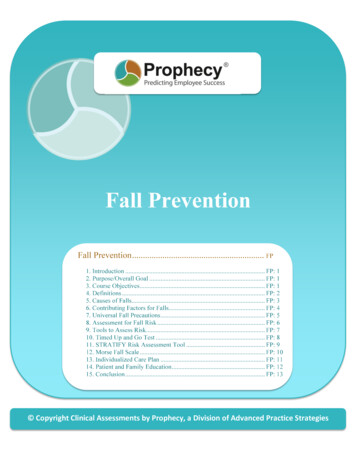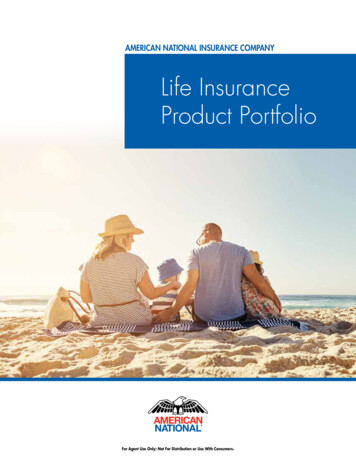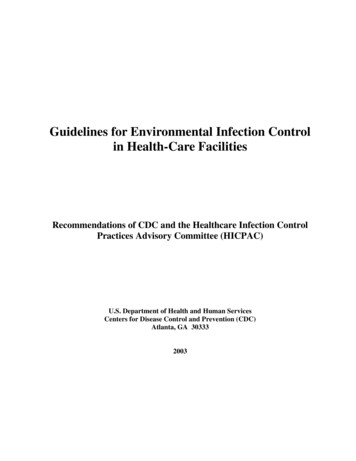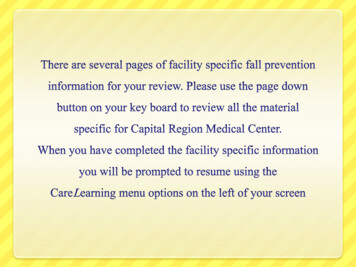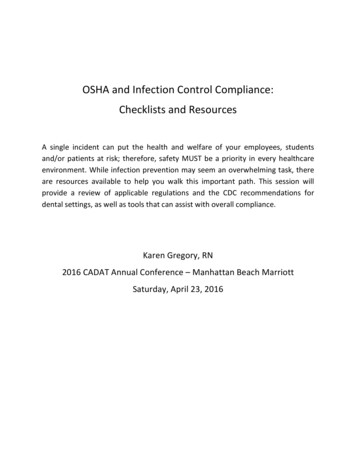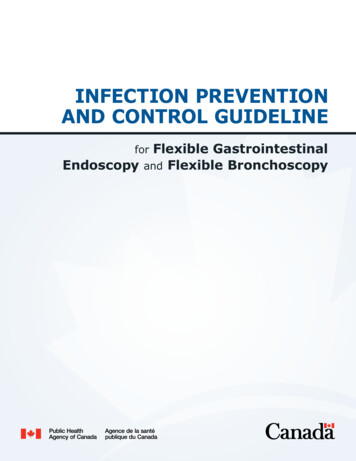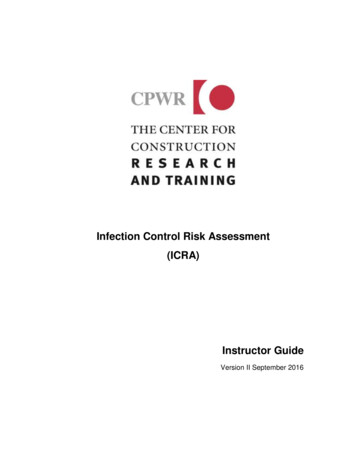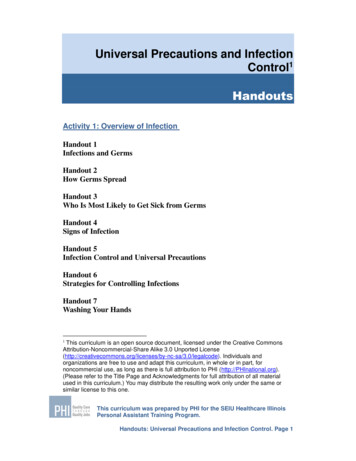
Transcription
Universal Precautions and InfectionControl1HandoutsActivity 1: Overview of InfectionHandout 1Infections and GermsHandout 2How Germs SpreadHandout 3Who Is Most Likely to Get Sick from GermsHandout 4Signs of InfectionHandout 5Infection Control and Universal PrecautionsHandout 6Strategies for Controlling InfectionsHandout 7Washing Your Hands1This curriculum is an open source document, licensed under the Creative CommonsAttribution-Noncommercial-Share Alike 3.0 Unported sa/3.0/legalcode). Individuals andorganizations are free to use and adapt this curriculum, in whole or in part, fornoncommercial use, as long as there is full attribution to PHI (http://PHInational.org).(Please refer to the Title Page and Acknowledgments for full attribution of all materialused in this curriculum.) You may distribute the resulting work only under the same orsimilar license to this one.This curriculum was prepared by PHI for the SEIU Healthcare IllinoisPersonal Assistant Training Program.Handouts: Universal Precautions and Infection Control. Page 1
Universal Precautions and Infection ControlActivity 2: Infection Control Strategies, Universal Precautions,and Consumer EducationHandout 8Wearing GlovesHandout 9Cleaning Up GermsHandout 10Making Cleaning ProductsActivity 3: Demonstration and Practice Lab: Hand Washing,Using Gloves, and Mixing Universal SolutionsHandout 11Build Your Skills: Washing Your HandsHandout 12Build Your Skills: Putting On and Taking Off GlovesActivity 4: Demonstration: Disposing of WastesHandout 13Touching and Washing Dirty Laundry SafelyHandout 14Getting Rid of Wastes SafelyHandout 15Getting Rid of Sharps SafelyThis curriculum was prepared by PHI for the SEIU Healthcare IllinoisPersonal Assistant Training Program.Handouts: Universal Precautions and Infection Control. Page 2
Universal Precautions and Infection ControlInfections and GermsHandout 1It’s important to understand infections and how they spread. Here’swhat you need to know.What are infections?Infections are problems or diseases that happen when germs get intothe body and grow.What are germs?Germs are tiny living things. They live almost everywhere, insideand outside our bodies. Some germs help people. Others causeproblems or diseases.Types of germs include: Bacteria Fungi Parasites VirusesThis curriculum was prepared by PHI for the SEIU Healthcare IllinoisPersonal Assistant Training Program.Handouts: Universal Precautions and Infection Control. Page 3
Universal Precautions and Infection ControlHandout 2How Germs SpreadPage 1 of 4Infection is spread in 3 stages:Stage 1Germs live in a host. The host may be a person or an animal.Stage 2The germs move out of the first host.Stage 3The germs move into a new host.Coronavirus 19 spreads the same way as other infections and can bedefined as a respiratory illness caused by a new strain of coronavirus. It isimportant to get tested for COVID-19 for the safety of yourself and others.TestingThere are two kinds of tests available: viral tests and antibody tests. A viral test tells you if you have a current infection. This test uses along swab to collect material from the back of the nose where itmeets the throat. An antibody test, which is a blood test, might tell you if you had apast infection. An antibody test might not show if you have a currentinfection because it can take 1–3 weeks after the infection for yourbody to make antibodies. Having antibodies to the virus that causesCOVID-19 might provide protection from getting infected with thevirus again.The CDC guidance for what to do if you are sick is:If you have a fever, cough or other symptoms, you might have COVID-19.Most people have mild illness and are able to recover at home. If you thinkyou might have been exposed to COVID-19, contact your healthcareprovider.This curriculum was prepared by PHI for the SEIU Healthcare IllinoisPersonal Assistant Training Program.Handouts: Universal Precautions and Infection Control. Page 4
Universal Precautions and Infection ControlHandout 2PreventionPage 2 of 4The best way to prevent illness is to avoid being exposed or exposingothers to a virus or other germs.You can protect yourself by: Washing your hands often with soap and water for at least 20seconds especially after you have been in a public place, or afterblowing your nose, coughing, or sneezingo If soap and water are not readily available, use a handsanitizer that contains at least 60% alcohol. Cover allsurfaces of your hands and rub them together until they feeldry. Avoiding contact with people who are sick. Stay 6 feet (about 2arms’ length) from other people. Covering your mouth and nose with a mask when around others.Everyone should wear a mask in public settings and when aroundpeople who don’t live in their household. Always covering your mouth and nose with a tissue when youcough or sneeze or use the inside of your elbow and do not spit.Throw used tissues in the trash and wash your hands immediately. Cleaning AND disinfecting frequently touched surfaces daily. Thisincludes tables, doorknobs, light switches, countertops, handles,desks, phones, keyboards, toilets, faucets, and sinks. Being alert for symptoms. Watch for fever, cough, shortness ofbreath, or other symptoms of COVID-19. It is especially important ifyou are running essential errands, going into the office or workplace,and in settings where it may be difficult to keep a physical distanceof 6 feet. Take your temperature if symptoms develop.This curriculum was prepared by PHI for the SEIU Healthcare IllinoisPersonal Assistant Training Program.Handouts: Universal Precautions and Infection Control. Page 5
Universal Precautions and Infection ControlHow Germs SpreadHandout 2Page 3 of 4Germs use many routes to get from one host to another. Here are sixways that germs spread:1. Through the airThe first host coughs, sneezes or exhales droplets. The new hostbreathes in the germs.2. Through animal bites3. Through insect bites4. Through eating or drinking infected food or waterThis curriculum was prepared by PHI for the SEIU Healthcare IllinoisPersonal Assistant Training Program.Handouts: Universal Precautions and Infection Control. Page 6
Universal Precautions and Infection ControlHow Germs SpreadHandout 2Page 4 of 45. Through touchingThe first host and the new host touch each other. Germs move fromone open sore to another. Scabies and lice spread from one body toanother.6. Through body fluidsGerms get out of the first host in: Blood Fluid from a cut Fluid from a penis or vagina Mucus Pus Saliva Stools Urine VomitGerms get into the new host when infected body fluids: Are on a needle or other sharp thing that goes into the skin ofthe new host Get into a cut or scratch Touch mucus membranes, like those inside your mouthThe CDC offers additional guidance for people who care for a person witha disability at the following lThis curriculum was prepared by PHI for the SEIU Healthcare IllinoisPersonal Assistant Training Program.Handouts: Universal Precautions and Infection Control. Page 7
Universal Precautions and Infection ControlWho Is Most Likely to Get Sick from GermsHandout 3Some people are more likely than others to get sick from germs. They aresusceptible to germs.Susceptible people may be: Already sick Under stress Very old Very tired Very youngSusceptible people may be people who: Don’t eat a healthy diet Don’t wash their hands well Have a weak immune system. That means their body is notgood at fighting off things from outside.This curriculum was prepared by PHI for the SEIU Healthcare IllinoisPersonal Assistant Training Program.Handouts: Universal Precautions and Infection Control. Page 8
Universal Precautions and Infection ControlHandout 4Signs of InfectionPage 1 of 2It’s important to know the signs of infection. Here’s what to look for.If a cut is infected: Fluid comes out of the cut. The cut hurts. The skin around the cut is red and puffy. It feels warm.If a body part or body system is infected, a consumer may feel: Pain in the infected area Sick to their stomach, or throw up Very hot or cold Very tiredWhat To Do If You Are SickStay at home except to get medical care. Isolate if you are sick. Isolation isused to separate people infected with the virus from people who are notinfected. In the home, anyone sick should separate themselves from othersby staying in a specific “sick room” or area and using a separate bathroomif available. People who are in isolation should stay home until it is safe forthem to be around others. You can be with others after: At least 14 days since symptoms first appeared and At least 24 hours with no fever without fever-reducingmedication and Symptoms have improvedQuarantine is used to keep someone who might have been exposed toCOVID-19 away from others. Those who have been exposed to COVID-19include encountering someone who has been diagnosed with COVID-19 orif you’ve been in a setting where you were not able to social distance.Quarantine helps prevent spread of disease that can occur before a personknows they are sick or if they are infected with the virus without feelingsymptoms. People in quarantine should stay home, separate themselvesfrom others, monitor their health, and follow directions from their state orThis curriculum was prepared by PHI for the SEIU Healthcare IllinoisPersonal Assistant Training Program.Handouts: Universal Precautions and Infection Control. Page 9
Universal Precautions and Infection Controllocal health department.Handout 4If you are sick you should also:Page 2 of 2 Avoid public transportation, ride sharing, taxis, or any situationwhere you would be in an enclosed space with someone Monitor yourself of COVID-19 symptoms including fever, cough,and shortness of breath Wear face masks over your nose and mouth if you must be aroundother people or animals Cover your mouth and nose with a tissue when you cough or sneezeand throw away the used tissues. Immediately wash your hands withsoap and water for at least 20 seconds or use a hand sanitizer thatcontains at least 60 % of alcohol Clean and disinfect high-touch surfaces in your home including the“sick room” and bathrooms. Wear a face mask and disposablegloves.This curriculum was prepared by PHI for the SEIU Healthcare IllinoisPersonal Assistant Training Program.Handouts: Universal Precautions and Infection Control. Page 10
Universal Precautions and Infection ControlInfection Control and Universal PrecautionsHandout 5What is infection control?Infection control is anything you do to prevent or stop germs fromspreading.Take these steps to control infections: Wash your hands. Do not touch consumers’ body fluids. Wear gloves, an apron, and a mask, as needed. Get rid of germs on things and in work areas. Put waste in the right place.What are universal precautions?You cannot always tell if someone is infected just by looking atthem. So you need to follow these rules every time you workwith a consumer. This is called universal precautions.This curriculum was prepared by PHI for the SEIU Healthcare IllinoisPersonal Assistant Training Program.Handouts: Universal Precautions and Infection Control. Page 11
Universal Precautions and Infection ControlStrategies for Controlling InfectionsHandout 6Page 1 of 3It’s important to understand how to control infections. Follow these general rules.To keep germs from spreading: Cover your mouth when you cough or sneeze. Frequently wash your hands. Don’t touch your face or eyes. Do not come to work when you’re sick. Eat a healthy diet. Keep your nails short. Wash your hands. Wear a mask and gloves, as needed. Wear simple jewelry.Daily Life and Going OutAs communities and businesses are opening, you may be looking for waysto resume some daily activities as safely as possible. If you decide toengage in public activities, continue to protect yourself by practicingeveryday preventive actions.Use online services when available. Order food and other items online forhome delivery or curbside pickup. If shopping in store, disinfect theshopping cart with disinfectant wipes and/or use hand sanitizer often. Forfood deliveries and takeout, pay online or over the phone when you can andopt for contact-less deliveries when food is delivered to your home.When attending an event or gathering, prioritize attending outdoor activitiesover indoor activities where there is more ventilation or arrive during offpeak times to avoid crowding and congested areas. Elect for virtualclasses/training sessions where possible to substitute in-person activities.This curriculum was prepared by PHI for the SEIU Healthcare IllinoisPersonal Assistant Training Program.Handouts: Universal Precautions and Infection Control. Page 12
Universal Precautions and Infection ControlHandout 6 Follow these specific rules.Page 2 of 3When you cook: Clean cooking areas before and after cooking meat, fish, andpoultry.Put away food carefully.Rinse can tops before opening them.Wash fruits and vegetables before eating or cooking them.Wash meat, fish, and poultry before cooking them.When you clean: Wear gloves Keep your work area clean and free of insects. Put dirty linens in a laundry bag. Put out clean towels often. Throw away waste and used needles in the right place.If you are concerned about potential contamination on yourgroceries, you can take additional steps to protect yourself suchas: Wiping or washing cans and boxes of food with adisinfectant before storing them to reduce possible viruscontent. Discard packaging and transfer food to a clean bag orcontainer. For fruits and vegetables, rinse completely with cleanwater before storing. Wash any tables, countertops, or other surfaces that weretouched by your groceries or grocery bags. If you’re using cloth bags, wash them with laundry soap ina washing machine and dry them thoroughly before reusingthem.This curriculum was prepared by PHI for the SEIU Healthcare IllinoisPersonal Assistant Training Program.Handouts: Universal Precautions and Infection Control. Page 13
Universal Precautions and Infection ControlReduce the Spread of InfectionHandout 6Page 3 of 3Face masks are recommended as a simple barrier to help preventrespiratory droplets from traveling into the air and onto other people.Wearing a face mask reduces droplets from coughs, sneezes, talking,or raising your voice. This is called source control.The risk of infection is very high when no one wears a mask. If youare sick you should wear a mask to significantly reduce the risk ofinfection to others. When everyone wears a mask the risk ofspreading infection is at its lowest.Social distancing of at least 6 feet and routine hand washing shouldstill be followed in addition to face masks to further reduce the riskof infection.This curriculum was prepared by PHI for the SEIU Healthcare IllinoisPersonal Assistant Training Program.Handouts: Universal Precautions and Infection Control. Page 14
Universal Precautions and Infection ControlWashing Your HandsHandout 7Page 1 of 2Why should you wash your hands?Washing your hands is the best way to control infections!When should you wash your hands?General Rules:Wash your hands: Before you touch a consumer. This protects the consumerfrom your germs. After you touch a consumer and before touching other peopleor things. This prevents you from spreading the consumer’sgerms. After you touch any thing or surface that could have germs onit.Specific Rules:Wash your hands before you: Leave a consumer’s homeWash your hands after you: Cough, sneeze, or blow your nose Get to a consumer’s home Tear your glove Use the toiletThis curriculum was prepared by PHI for the SEIU Healthcare IllinoisPersonal Assistant Training Program.Handouts: Universal Precautions and Infection Control. Page 15
Universal Precautions and Infection ControlHandout 7Washing Your HandsPage 2 of 2Wash your hands before and after you: Eat, drink, or touch food Put on your makeup or lip balm Smoke Do a task that involves touching a consumer Touch items used in personal care, like a toothbrush Touch your contact lenses Wear glovesQuestions and Answers Question: The consumer’s saliva is on my elbow. What should Ido?Answer: Sometimes a part of your body touches things that mayhave germs on them. If this happens, wash the part with soap andwater right away. If germs get in your eyes, nose, or mouth, rinsethem well with plenty of water. Question: I know that germs live on faucets and inside sinks.How should I wash my hands?Answer: Have a clean paper towel ready. Use it to turn the faucet onand off. If you touch the inside of the sink, wash your hands again.This curriculum was prepared by PHI for the SEIU Healthcare IllinoisPersonal Assistant Training Program.Handouts: Universal Precautions and Infection Control. Page 16
Universal Precautions and Infection ControlWearing GlovesHandout 8Page 1 of 2It’s important to understand how to wear gloves. Here’s what you needto know.Why should you wear gloves?Wearing gloves keeps you from touching body fluids. Body fluidshave germs in them.When should you wear gloves?In general, wear gloves any time you might touch body fluids.Follow these specific rules for when to wear gloves.Wear gloves when you: Change bandages or dressings Clean areas where body fluids have spilled Collect or touch urine or stool samples Press down to stop bleeding Touch dirty items used in personal care Touch dirty or bloody linens, towels, or clothesWear gloves when you assist consumers to: Bathe Take care of their mouth Clean between their legs Use a toilet, bedpan, or urinal Change their pad or brief Take care of their catheterThis curriculum was prepared by PHI for the SEIU Healthcare IllinoisPersonal Assistant Training Program.Handouts: Universal Precautions and Infection Control. Page 17
Universal Precautions and Infection ControlWearing GlovesHandout 8Page 2 of 2How often should you wear gloves?Use gloves only once. Never use them again, even if you wash them.If a glove tears: Take off both gloves right away. Wash your hands well. Put on another pair of gloves.Questions and Answers Question: One of the people I help is coughing and sneezing alot. Other than gloves, what can I wear to protect myself fromgerms?Answer: You can wear a mask. Question: Sometimes the bed linens are very dirty. What can Iwear to protect my clothes when I change the sheets?Answer: You can wear an apron. You can also wear an apron whenyou assist a consumer to bathe.This curriculum was prepared by PHI for the SEIU Healthcare IllinoisPersonal Assistant Training Program.Handouts: Universal Precautions and Infection Control. Page 18
Universal Precautions and Infection ControlCleaning Up GermsHandout 9Page 1 of 3Why should you clean up germs?Cleaning up germs keeps the consumer, family members, visitors,and you from getting sick.How should you clean up germs?To clean dishes: Wash the consumer’s dishes with warm water and dish soap. Rinse and air-dry the dishes. If you dry dishes with a towel,use a clean towel each time.To clean items used in personal care: Handle razors with care. Throw them away the same way youthrow away needles. Wash thermometers in cool water and soap. Wipe them withalcohol before and after use. Make sure the consumer does not share personal care itemswith other family members.To clean spilled body fluids: Put on gloves. Wipe up the spill with paper towels. Throw away the paper towels in the garbage. Use 2 bags. Take off and throw away your gloves. Wash your hands. Use bleach and water solution to get rid of germs.Wear special gloves.Wear rubber utility gloves. They will protect your hands fromcleaning products. Do not wear latex gloves.This curriculum was prepared by PHI for the SEIU Healthcare IllinoisPersonal Assistant Training Program.Handouts: Universal Precautions and Infection Control. Page 19
Universal Precautions and Infection ControlHandout 9Page 2 of 3According to the CDC, wearing gloves outside of these instances (forexample, when using a shopping cart or using an ATM) will not necessarilyprotect you from getting COVID-19 and may still lead to the spread ofgerms. The best way to protect yourself from germs when running errandsand after going out is to regularly wash your hands with soap and water for20 seconds or use hand sanitizer with at least 60% alcohol. Wear reusable or disposable gloves for routine cleaning anddisinfection. Clean surfaces using soap and water, then use disinfectant. Cleaning with soap and water reduces number of germs, dirt andimpurities on the surface. Disinfecting kills germs on surfaces. Practice routine cleaning of frequently touched surfaces. High touchsurfaces include: Tables, doorknobs, light switches, countertops, handles, desks,phones, keyboards, toilets, faucets, sinks, etc.This curriculum was prepared by PHI for the SEIU Healthcare IllinoisPersonal Assistant Training Program.Handouts: Universal Precautions and Infection Control. Page 20
Universal Precautions and Infection ControlCleaning Up GermsHandout 9Page 3 of 3Use different cleaning products for different jobs.Use detergent and hot water to clean: Clothes Dishes Sheets and towelsUse bleach and water to clean: Bathroom and kitchen surfaces Spilled body fluids ToiletsUse vinegar and water to clean and prevent odors on: Surfaces in the bathtub, shower, and kitchen Urinals, bedpans, commodes, and toiletsThis curriculum was prepared by PHI for the SEIU Healthcare IllinoisPersonal Assistant Training Program.Handouts: Universal Precautions and Infection Control. Page 21
Universal Precautions and Infection ControlMaking Cleaning ProductsHandout 10Page 1 of 2Here’s how to make bleach and water solution, or “universal solution.”You will need: 1-cup measuring cup Empty plastic bottle with a cap. Make sure it can hold morethan 11 cups of fluid. Label and marker, or permanent marker Liquid bleach Rubber utility gloves WaterTake these steps:1. Wash your hands.2. Put on gloves.3. Measure 10 cups of water. Pour them into the bottle.4. Measure 1 cup of bleach. Pour it into the bottle.5. Put the cap on the bottle. Shake the bottle.6. Write “Bleach solution 1:10” and the date on the label or bottle.7. Put away the solution and the things you used. Keep the solutionand the bleach out of reach of children.8. Take off and rinse the gloves. Hang them up to dry.9. Wash your hands.This curriculum was prepared by PHI for the SEIU Healthcare IllinoisPersonal Assistant Training Program.Handouts: Universal Precautions and Infection Control. Page 22
Universal Precautions and Infection ControlMaking Cleaning ProductsHandout 10Page 2 of 2Here’s how to make vinegar and water solution.You will need: 1-cup measuring cup Empty plastic bottle with a cap. Make sure it can hold morethan 4 cups of fluid. Label and marker, or permanent marker Water White vinegarTake these steps:1. Wash your hands.2. Measure 3 cups of water. Pour them into bottle.3. Measure 1 cup of vinegar. Pour it into the bottle.4. Put the cap on the bottle. Shake the bottle.5. Write “Vinegar solution 1:3” and the date on the label or bottle.6. Put away the solution and the things you used. Keep the solutionout of reach of children.7. Wash your hands.This curriculum was prepared by PHI for the SEIU Healthcare IllinoisPersonal Assistant Training Program.Handouts: Universal Precautions and Infection Control. Page 23
Universal Precautions and Infection ControlBuild Your Skills: Washing Your HandsHandout 11Get ready to wash your hands.1. Get soap and paper towels before beginning; roll up sleeves.2. Stand back from the sink. Your clothes and hands must not touch thesink.3. Turn on the water with a dry paper towel. Make it warm andcomfortable.Wash your hands.4. Get your hands wet. Point your fingertips down.5. Put liquid soap on your hands and wrists.6. Rub your hands, fingers, and wrists. Clean between your fingers. Rubyour hands with soap for 30 seconds. (That’s about how long it takesto sing “Happy Birthday” two times.)7. Rinse your hands. Rub them under the water for at least 30 seconds.Dry your hands.8. Dry your hands with a clean paper towel. Do not shake water off yourhands.9. Turn off the water with a clean paper towel.10. Throw the paper towel in the garbage.This curriculum was prepared by PHI for the SEIU Healthcare IllinoisPersonal Assistant Training Program.Handouts: Universal Precautions and Infection Control. Page 24
Universal Precautions and Infection ControlBuild Your Skills: Putting On and Taking OffGlovesHandout 12Put on gloves.1. Wash your hands.2. Dry your hands well with a paper towel.3. Check the gloves for tears or holes. Do not use the gloves if you findany.4. Put the gloves on when you are ready to work with a consumer.Take off gloves.5. Use your gloved right hand to hold the left glove, near the wrist. Donot touch bare skin.6. Peel the left glove off from the wrist. It should now be inside out.7. Ball up the left glove in your right hand. Leave it inside out.8. Put two fingers of your left hand inside the right glove. Do not touchthe outside of the glove with your bare hand.9. Peel the right glove off from the wrist. It should now be inside out,over the left glove.10. Throw away the gloves in the right place.11. Wash your hands.This curriculum was prepared by PHI for the SEIU Healthcare IllinoisPersonal Assistant Training Program.Handouts: Universal Precautions and Infection Control. Page 25
Universal Precautions and Infection ControlTouching and Washing Dirty Laundry SafelyHandout 13Page 1 of 2Why should you handle dirty laundry with care?Dirty laundry may have body fluids on it. Body fluids have germs inthem. Germs can make people sick.How should you handle dirty laundry?Take these steps:1. Put on gloves and an apron.2. Put a laundry bag where you can reach it.3. Roll items away from your body. Wrap the dirty areas inside theclean areas.4. Never shake out dirty laundry. This can put germs into the air.5. Put dirty laundry right into the laundry bag. Do not put dirtylaundry on the floor, on a chair, or on a counter.6. Take off your gloves. Wash your hands.How should you wash dirty laundry?To wash dirty white laundry:1. Soak very dirty items in a bleach solution for at least 10 minutes.2. Wash the laundry in the washing machine with 1 cup of bleach.3. Wash the laundry with regular laundry soap.4. Dry the laundry in the dryer.This curriculum was prepared by PHI for the SEIU Healthcare IllinoisPersonal Assistant Training Program.Handouts: Universal Precautions and Infection Control. Page 26
Universal Precautions and Infection ControlHandout 13Touching and Washing Dirty Laundry SafelyPage 2 of 2To wash dirty colored laundry:1. Wash the laundry in the washing machine with 1 cup ofhousehold disinfectant, such as Lysol .2. Wash the laundry with regular laundry soap.3. Dry the laundry in the drier.To wash laundry by hand:1. Use a basin, bathroom sink, or bathtub. Never use the kitchensink.2. Put on gloves.3. Wash the laundry in 1 ounce of disinfectant per gallon of water,plus detergent.4. Rinse the laundry well at least 3 times.5. Clean the basin, sink, or tub with universal solution.This curriculum was prepared by PHI for the SEIU Healthcare IllinoisPersonal Assistant Training Program.Handouts: Universal Precautions and Infection Control. Page 27
Universal Precautions and Infection ControlGetting Rid of Wastes SafelyHandout 14Page 1 of 2Why should you handle wastes with care? Body fluids and things that touch body fluids have germs inthem. Germs can make people sick.How should you get rid of body fluids? Flush them down the toilet.Body fluids include: Stools Urine VomitThings that touch body fluids are called waste materials.Waste materials include: Used briefs and pads Used catheters Used dressings and bandages Used paper towels Used tissuesThis curriculum was prepared by PHI for the SEIU Healthcare IllinoisPersonal Assistant Training Program.Handouts: Universal Precautions and Infection Control. Page 28
Universal Precautions and Infection ControlGetting Rid of Wastes SafelyHandout 14Page 2 of 2How should you get rid of waste materials?Always double-bag waste materials.Take these steps:1. Keep a garbage can for waste materials in the consumer’s room.Line it with 2 plastic bags. The inner bag is “dirty.” The outer bagis “clean.”2. Put on gloves. Put on an apron if your clothes may get dirty. Puton glasses and a mask if fluids may splash your face.3. Put the waste materials in the inner bag.4. Close the inner bag tightly.5. Take off your gloves, apron, glasses, and mask. Put them in theclean bag.6. Wash your hands (so that you don’t make the outside of the cleanbag “dirty”).7. Close the clean bag. Take it out of the consumer’s room.8. Throw the double-bagged waste materials away with othergarbage—but only if you are sure it will stay out of reach ofanimals and children.This curriculum was prepared by PHI for the SEIU Healthcare IllinoisPersonal Assistant Training Program.Handouts: Universal Precautions and Infection Control. Page 29
Universal Precautions and Infection ControlGetting Rid of Sharps SafelyHandout 15Page 1 of 2What are sharps? Used needles and razorsWhy should you handle sharps with care? Used needles and razors have body fluids on them. Body fluidshave germs in them. So if you get stuck with a needle or cut witha razor, you can get sick. Needles and razors can tear through garbage bags. So they needto go in a sharps box.How should you get rid of sharps?You will need: Gloves Label or permanent marker Plastic bags Sharps box made of tough plastic with a capThis curriculum was prepared by PHI for the SEIU Healthcare IllinoisPersonal Assistant Training
Testing There are two kinds of tests available: viral tests and antibody tests. A viral test tells you if you have a current infection. This test uses a long swab to collect material from the back of the nose where it meets the throat. An antibody test, which is a blood test, might tell you if you had a past infection.
